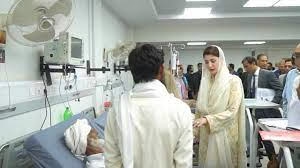In the province of Punjab, Pakistan, a significant outbreak of pinkeye, scientifically known as conjunctivitis, has emerged as a major health concern. State-run hospitals in the region have reported an alarming increase of 500-600 cases, with Lahore being the hardest-hit district.
This sudden surge in pinkeye infections is causing anxiety, particularly because it is affecting individuals of all age groups. Of particular concern is the rising number of school children reporting eye infections, mainly due to lapses in preventive measures at educational institutions.
Reports indicate that schools are taking swift action by allowing infected students to stay home and advising parents to provide special care for their children. Medical experts note that pinkeye is spreading rapidly in densely populated urban areas where people are frequently exposed to less-than-ideal environmental conditions such as factories, markets, and shopping plazas.
Lahore, in particular, is grappling with this outbreak, with nearly 40 percent of reported cases originating in the city. Hospitals in Lahore are witnessing a daily influx of over 200 pinkeye patients.
Experts in the field of ophthalmology are expressing concerns about the potential for widespread transmission of the infection due to a lack of precautions, commonly referred to as viral conjunctivitis.
Renowned ophthalmologist and former Vice Chancellor of King Edward Medical University, Professor Dr. Asad Aslam, emphasizes that it is too early to determine the full impact of viral conjunctivitis or pinkeye, as efforts are underway to officially document the exact number of cases.
Dr. Aslam explains that pinkeye is a common, self-limiting condition that affects the lining of the eyelid and eyeball. Fortunately, it is treatable at any stage. He stresses that the infection can easily spread through contact with contaminated surfaces, close contact with infected individuals, and even through simple conversations. Patients are strongly urged to exercise extreme caution.
As a preventive measure, Dr. Aslam recommends that individuals with pinkeye wear dark glasses and immediately separate their bedding and utensils from those of others. He notes that while an increase in pinkeye cases is observed in Punjab every year, the intensity of this year’s outbreak surpasses previous records.
Regarding high-risk transmission, Dr. Aslam explains that the virus can spread when an infected person touches their eyeball and subsequently comes into contact with other surfaces or individuals. It’s essential to note that pinkeye can also result from bacterial infections or allergic reactions. Dr. Aslam emphasizes that if symptoms do not improve within 12 to 24 hours, individuals should seek a doctor’s appointment promptly to prevent complications.
The pinkeye outbreak in Punjab underscores the importance of adhering to preventive measures and seeking timely medical attention to curb the spread of this contagious eye infection. Public health authorities and medical professionals are diligently working to manage the situation and provide necessary guidance to the affected population.



